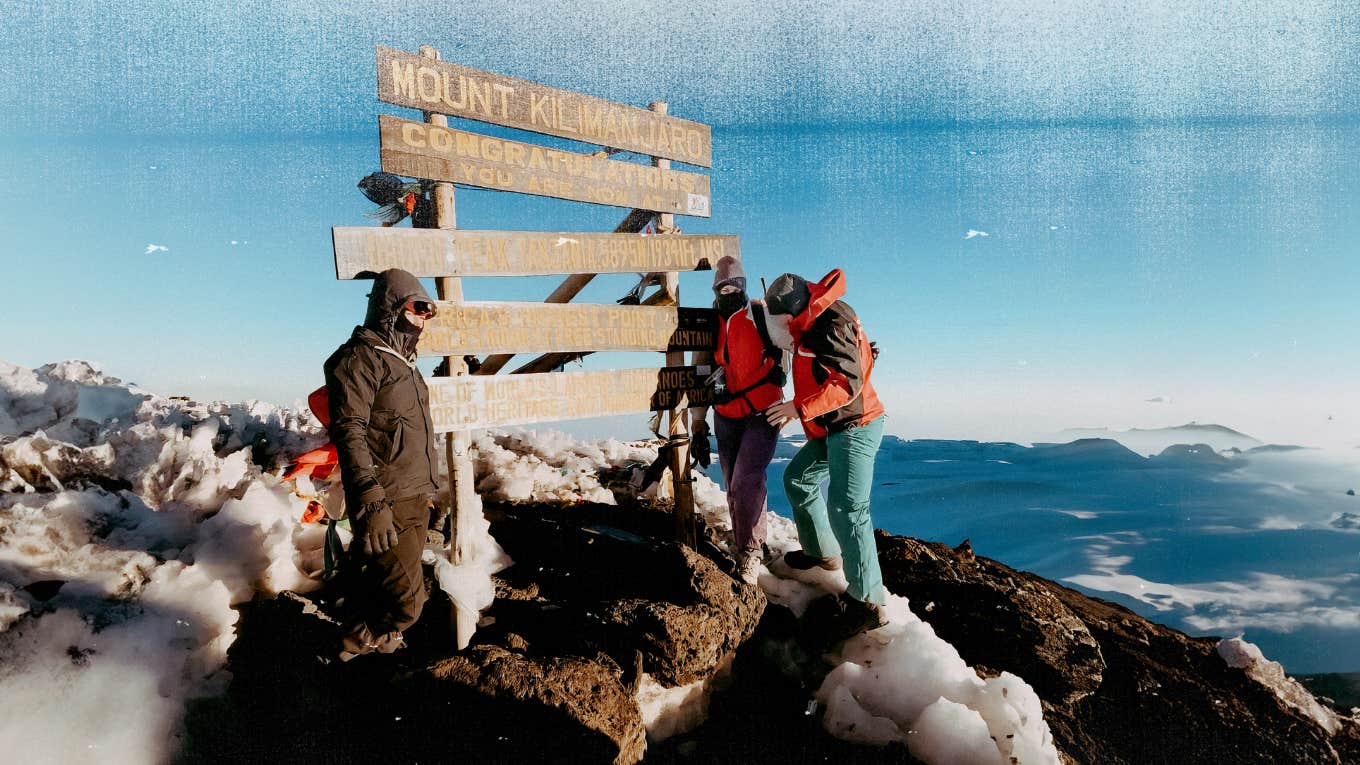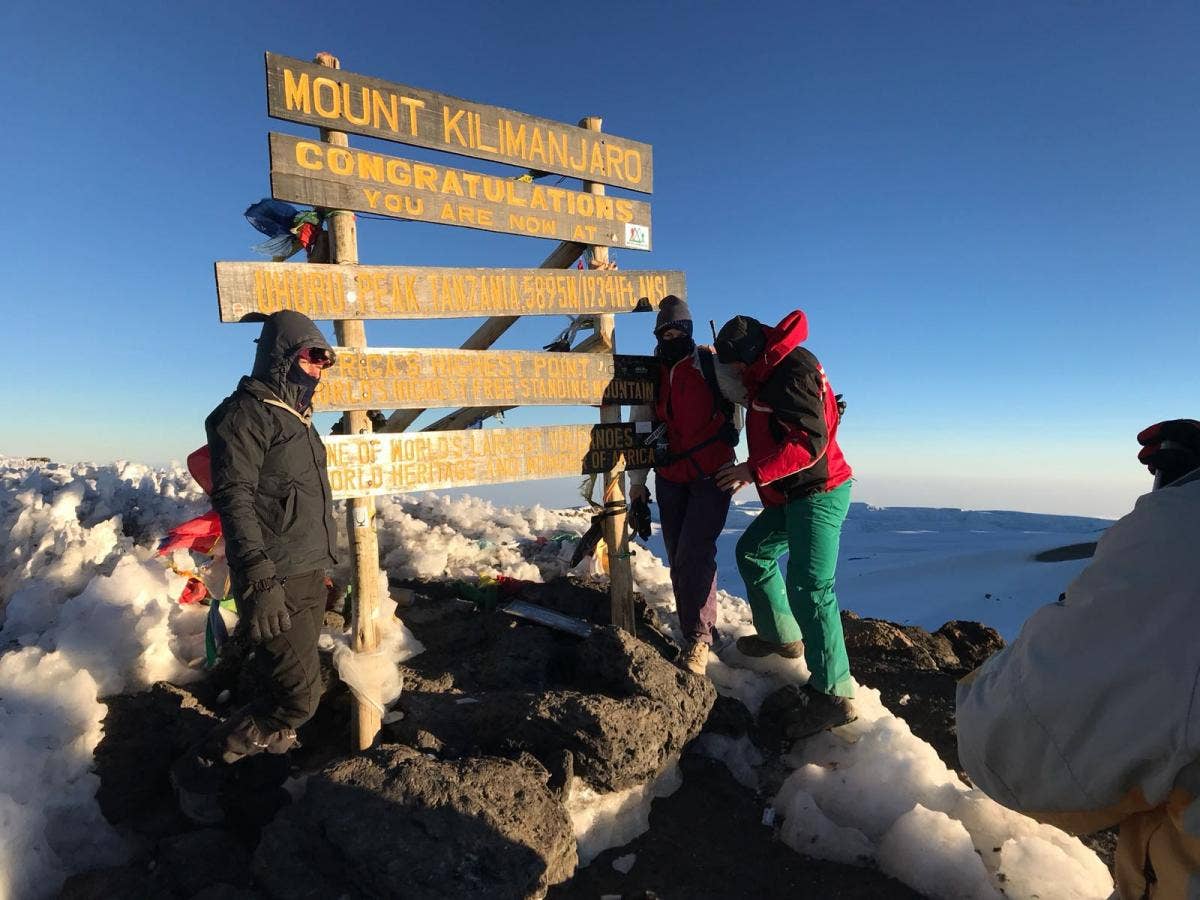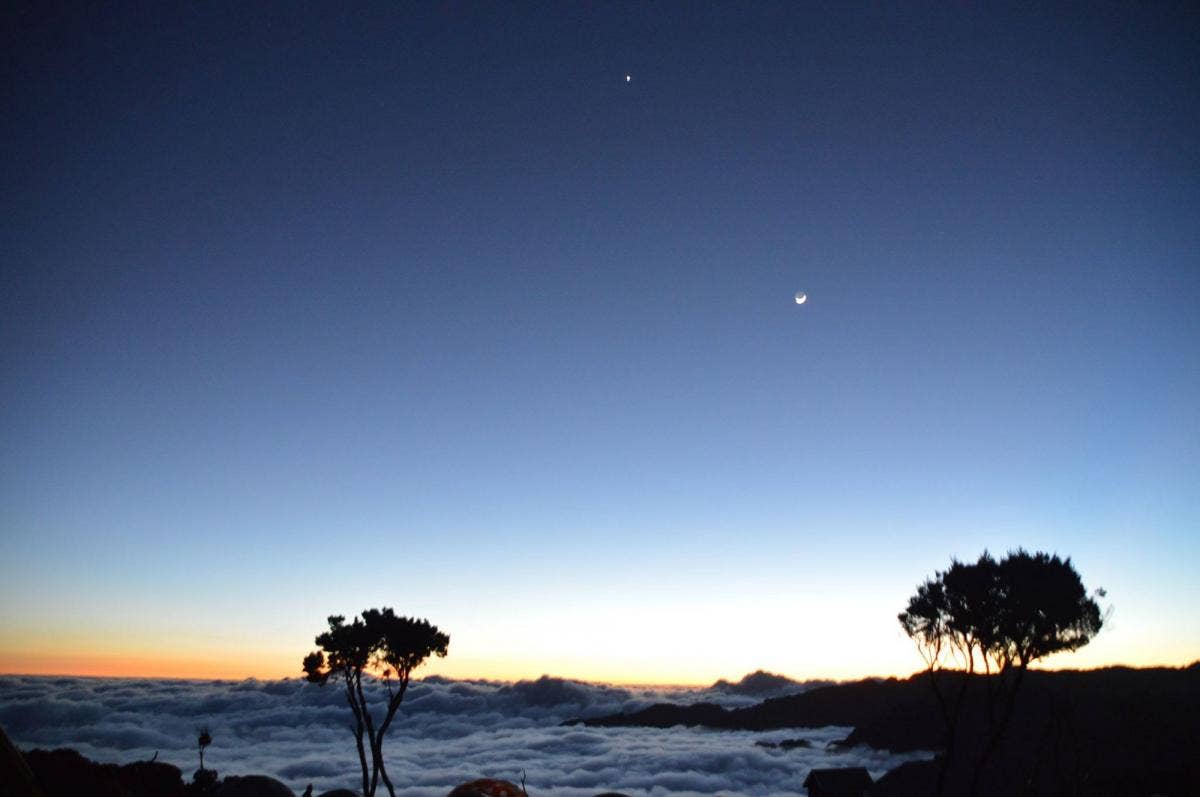6 Life-Altering Lessons I Learned From Climbing Kilimanjaro
I climbed a mountain and ended up a different person on the other side.
 Courtesy Of Author
Courtesy Of Author “Kilimanjaro is a snow-covered mountain 19,340 feet high and is said to be the highest mountain in Africa. Its summit is called the Masai ‘Ngaje Ngai,’ the House of God. Close to the western summit, there is the dried and frozen carcass of a leopard. No one has explained what the leopard was seeking at that altitude.” -Ernest Hemingway
Mount Kilimanjaro lies across the borders of Kenya and Tanzania in east Africa. While it is the highest free-standing mountain in the world and the tallest on the African continent, Kilimanjaro is a popular climb with tourists because it involves no technical climbing. Despite this, the success rate of reaching the peak is around 50–70%. She will test your endurance, your strength, your will, and your spirit.
The climb is compared to walking from the Equator to the North Pole in a week, where the scenic changes in vegetation and climate present a feeling of traversing through different worlds in just a few hours. You trek through five climate zones: cultivated farmlands and fruit plantations; tropical rainforest; heather-moorlands (savannah plains); alpine desert (with volcanic rocks); and an arctic glazier summit. More zones than in a Sonic the Hedgehog video game.
Of the seven main routes used to climb Kilimanjaro (‘Kili’), the Machame route is the most popular path because it provides impressive views and a variety of habitats. The Machame route is also known as the ‘Whiskey’ route, given its reputation for being a tough climb, in contrast to easier paths known as the ‘Coca Cola’ routes. Climbers on the Machame hike face steeper trails and longer distances while sleeping in tents, rather than the more luxurious hut accommodation available on the mountain.
In August I was part of a group of seven climbers from England and Hong Kong attempting to hike up Kili. We did this following a week-long social action project in Moshi and Arusha. I and four others reached the 5895-meter summit just as the sun was rising, following an arduous and exhausting seven-hour trek in the pitch-dark and below-freezing temperatures. We’d only had a few hours’ sleep.

Photo: Author
Each of my fellow climbers showed tremendous fitness, determination, and resilience throughout the six-day hike. We suffered through the formidable effects of altitude sickness — headaches, nausea, and fatigue. Part of the mystery of altitude sickness is that it’s difficult to predict who will be affected. There are many stories of fit and healthy people — including famous athletes — having their ascent halted, while their older companions have felt fine. I was fortunate to have missed that curse. The climb was the most demanding thing I’ve ever done, even tougher than I thought it’d be — and the purpose of this article is to share what I learned from the experience.
Life can be very tough and arbitrary for us all. But having experienced this climb, all my usual worries and concerns pale in comparison to this. All things being equal — nothing or no one will faze me after it. People from the ‘Chaga’ tribe are found on the slopes of the mountain and believe that the summit of Kilimanjaro leads to the afterlife. On summit night I told myself that whatever I was looking for in life, was at its peak. Somehow. Everything I’d been pursuing and looking for.
The solution and answer to it all was waiting up there for me. What was this sacred knowledge, this esoteric epiphany-worthy wisdom? Was this some delirious nonsense I was telling myself to give some arbitrary meaning to walking up a very tall, steep hill? Or was this a genuine revelation, an experience that would profoundly change my life? I don’t know the answer to these questions, but I’m going to have a lot of fun finding out.
I'll do it or die: Here are 6 life-altering lessons I learned from climbing Mt. Kilimanjaro:
1. Find allies
A team of people pulling in the same direction can achieve far more than any single individual. We had a very cohesive team and support network of seven climbers and over 40 support staff. Egos were checked at the door. The New Zealand rugby team, the All Blacks has a ‘no jerks’ policy which is policed by the players.
Team adviser Gilbert Enoka describes jerks as “people putting themselves ahead of the team, people who think they’re entitled to things or expect the rules to be different for them, people operating deceitfully in the dark or being unnecessarily loud about their work.” Our team of climbers had no jerks. If we had, and if egos were brought up the mountain with us, we would have potentially: Faced a toxic environment — leading to resentment and disharmony in the team.
Lost the ‘buy-in’ every team needs, the vested interest in the same project. Empowered people in a team are more confident, more willing to go the extra mile for each other, and more willing to do whatever it takes. Descended into looking solely after our interests, not being team players — even if this was ultimately detrimental to us as individuals. To find allies means to partner with people in areas you share in common, and to invest time in getting to know people and discovering what makes them unique as individuals. Finding allies means compromising on the small things to realize the overarching goal — taking the chip off your shoulder. It also means challenging in the right spirit and pushing back where it is necessary, where the agreed approach is being undermined or neglected. If you want to go fast, go alone. But if you want to go far, go together.
2. Make firm commitments
I also mentally prepared myself by visualizing the mission over many months beforehand. In the weeks leading up to my outward flight, I promised myself that I would reach the top of the mountain — whatever it took. Even if it meant not coming down again. I didn’t have a death wish, but I decided that life was about overcoming adversity setting goals, and realizing them. I was prepared to risk it all in this context.
Easy for a 28-year-old with no family to say, but it was a firm commitment I made to myself nonetheless. I gave my climb, and the people I was with, and the mountain itself with the respect they deserved by treating the whole experience with awe and wonder. Equally, I made the decision that I would not submit, yield, or surrender to my limitations and weaknesses on the side of the mountain. I decided it was worth the risk. The expedition was one practical opportunity to demonstrate some of the things I have spoken and written about at length in these articles and my public speaking workshops.
I’d be an awful hypocrite if I didn’t at least attempt to practice some of what I preach! And one of these concepts I speak about is resolve — one of the most powerful, potent words in the English language. Resolve says: “I will.” Benjamin Disraeli once said, “Nothing can resist a human will that will stake even its existence on the extent of its purpose,” while Jim Rohn said, “Resolve means promising yourself you will never give up.” The world has a strange way of stepping aside when someone says: “I’ll do it or die.” Nothing can stop them. I told myself “I WILL climb the mountain.”
3. Mind over matter
To help me power through on summit night I frequently visualised things in my mind. I imagined many people I loved and respected being proud of me for getting to the top. I imagined the few people I didn’t like feeling disappointed and annoyed when they heard I had succeeded again. I pictured the looks on their faces. I played my favorite songs and film scenes in my mind– ones that prompted strong emotions in me. I cried several times on summit night as I channeled and converted these emotions and my sheer tiredness into raw energy to energize, motivate, and fuel my ascent.
My muscles ached, after 5 days of hiking. My body and mind were exhausted, on a few hours’ sleep. My lungs struggled with the lack of oxygen. My head pounded with headaches caused by the altitude. Despite the difficulty, you can do anything if you set your mind to it. One of our climbers Gary spoke about how he detached his mind from his body to keep going through it all. The mind is like a machine — it is always working, with you or against you, depending on the instructions you have given it.
4. Trust the process
My trek got off to a concerning start when I developed blurred vision on the first day. I effectively lost my long-range eyesight. I came very close to withdrawing then, fearing I was jeopardizing my eyesight. I persevered, remembering my promise to myself and thanks to my accommodating team the loss of clear vision did not delay or hinder us. I recovered the full use of my eyes during the final ascent, just in time to enjoy the beauty.
I adapted to my blurred vision on the trek, not being able to see much beyond a dozen inches around me. I relied on my climbers to help me at mealtimes (a very humbling experience to be consistently served because you’re not sure what food is there). I relied on our guides and the person immediately in front of me, following in their footsteps through all the terrains of the mountain. Head down, one foot in front of the other, all the way to the top. A lesson from my vision loss is that we only need to see the very important next step in the journey. We all need to keep our heads down and keep putting one foot in front of the other.
I can remember instances where I’ve been asked how a particular event went for me, or how things are going during a process (usually a chaotic one in the world of politics). My response to these has sometimes been, “Oh it was a blur”, or “You know, flying blind at the minute.” Never has this been as true as climbing Kili. It would have been easy and very understandable for me to have bailed at any point due to the blurred vision. For the first few hours of this worrying experience, I tried to keep it to myself, only reluctantly telling the head guide about it. After reassuring me that this was relatively common (likely a side-effect of the Diamox pills for altitude sickness) I placed my trust in him, my team, and the whole experience about to unfold before me. It was almost Biblical, like Saul’s Damascene conversion and temporarily losing his eyesight, while Thomas the doubting Apostle refused to believe unless he saw with his own eyes.
5. Pay your dues
Porters had the right of way on the mountain. We would stand aside, wait our turn, and let them pass us while going up and down the mountain. The system is this way for a good reason — their need to reach their destination is greater than ours. This is a valuable principle in life. There are systems in place that only work when every participant buys into the premise and respects the rules — the tax system, or free trade agreements for example. There are responsibilities and obligations as well as rights and privileges — a two-way street.
Our head guide Joel was the leader of our trek. He earns the respect of his staff and clients, not because of his position, but through the leadership and assuredness he showed in guiding us up the mountain. If he had told us on summit night to walk up the mountain backward, we would have done it. If he’d told us to strip naked and begin the climb I don’t think we would have questioned it. Learning to wait for one’s turn and respect the right of way is sage advice for any team endeavor.
Our porters also had to be tipped under a very specific system and in a very structured ceremony on our last morning on the mountain. This was a team effort, and our porter colleagues pitched our tents, carried our equipment, and cooked our wonderful meals for a whole week. Some of them went above and beyond to get us out of difficult spots on the mountain when we were too exhausted to keep moving. Paying your way, and playing by the rules when they are logical is not an attractive concept but it is a virtue.
6. Enjoy the journey

Photo: Author
The view of the sunrise from Kilimanjaro was beyond beautiful. I wish I had more time to enjoy and take it in. I was so focused on getting up there and then getting away from it that it was a fleeting moment. How true of life this is! We rush around chasing these mirages or things we think will bring happiness or fulfillment. They come and go. And we don’t appreciate them, nor the time spent getting there. A pity.
I told people I would be a different person coming down the mountain than the guy who went up it. We’re all climbing the mountains in our lives. Sometimes making great progress and enjoy the scenery, other times, we’re thinking about quitting and wondering why on earth we’re putting ourselves through this. The value and worth of these climbs lie not in the view from the summit, and not in the Instagram snaps you take to broadcast your achievement. It’s in the change you undergo to prepare for, and while making the ascent.
Success is an inside job. Climb Kilimanjaro not just so you can tell people you did it, or to tick the box. Do it so you can grow and develop into a stronger, more resilient, and more patient person. Don’t wish to be a millionaire just so you can look at the zeros on your bank balance. Don’t aspire to be one for the title or the AmEx card. Be a millionaire personality, someone who is wealthy in many more ways than financial terms. See what kind of individual you can be, what things you consistently have to do, and what useful service and contribution you can offer in exchange for these goals. See how high you can climb. See, at that altitude, what you’ll find, the changes you undergo, and the type of person you become. Just take the first step.
Stephen Lynch is a writer, speaker, author, and business coach.

